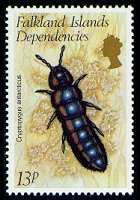Collembola
Pronunciation: [Col·LEM·bo·la]
Pronunciation: [Col·LEM·bo·la]
Common Name: Springtails
Greek Origins of Name: Collembola, derived from the Greek “coll” meaning glue and “embol” meaning a wedge, refers to a peg-shaped structure, the collophore, on the underside of the first abdominal segment. The collophore was once thought to function as an adhesive organ.
Ametabola, i.e. lacking metamorphosis; eggs hatch into young which are smaller than adults, but similar in appearance.
Apterygota; primitively wingless
Common in grassy or wooded habitats worldwide. Approximately 7 families and 677 species in North America and 20 families and >6000 species worldwide.
The springtails are among the most abundant of all soil-dwelling arthropods. They live in a variety of habitats where they feed as scavengers on decaying vegetation and soil fungi. Most species are small (less than 6 mm in length) and quite susceptible to desiccation unless they remain in a moist environment. A unique, tube-like structure, the collophore is located ventrally on the first abdominal segment of most species. The exact function of this organ is unknown, but it probably helps maintain water balance by absorbing moisture from the environment.
Springtails are named for a forked jumping organ (the furcula) found on the fourth abdominal segment. The furcula is retracted against the ventral wall of the abdomen and held there, in cocked position, by a special catch (the tenaculum) on the third abdominal segment. Releasing the tenaculum causes the furcula to snap down against the substrate and flip the organism some distance through the air. This device, present in all but a few genera, seems to be an effective adaptation for avoiding predation.
Immature collembola are similar in appearance to adults. They usually molt 4-5 times before reaching sexual maturity, and continue to molt periodically throughout the rest of their life. Unlike most other arthropods, springtails appear to have evolved in a cool climate. Their relative abundance in the soil tends to increase as the mean annual temperature decreases and their development is most rapid under cool, humid conditions.

Springtails are part of the community of decomposers that break down and recycle organic wastes. A few species feed on living plants and are occasionally regarded as pests: Bourletiella hortensis (the garden springtail) may damage seedlings in early spring, Sminthurus viridis (the lucerne flea) is a pest of alfalfa in Australia, and Hypogastrura armata has been a frequent pest of commercial mushrooms.
Hypogastruridae — the largest family in the order. These are small, plump hexapods that may lack compound eyes or a springtail (furcula). Includes the snowflea, Hypogastrura nivicola.
Isotomidae — second largest family in the order. These hexapods are elongate and lack scales on the upper surface of the body.
Entomobryidae — common soil-dwellers. The fourth abdominal segment is significantly longer than the others.
Sminthuridae — body globular in shape. The family includes the garden springtail (Bourletiella hortensis) which occasionally damages plant seedlings.
 This stamp, the fourth in a series of six depicting various arthropods, was issued by the Falkland Island Dependencies on March 16, 1982. It depicts Cryptopygus antarcticus, a soil-dwelling collembolan from the family Isotomidae.
This stamp, the fourth in a series of six depicting various arthropods, was issued by the Falkland Island Dependencies on March 16, 1982. It depicts Cryptopygus antarcticus, a soil-dwelling collembolan from the family Isotomidae.